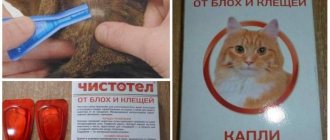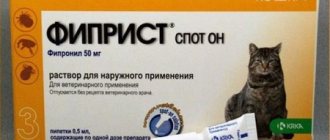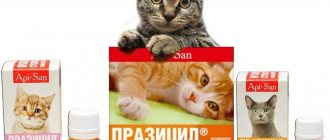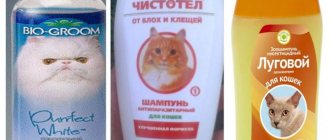Domestic drops and sprays Bars against fleas for cats and kittens are a universal insectoacaricide with a long period of protection. They are used against fleas, ixodid ticks, lice mites, and scabies mites as a therapeutic drug and as a means of prevention. The drug is safe for pets, but only if used according to recommendations.
The active ingredient of the drug and the method of its effect on fleas
The flea remedy Bars contains the main active ingredient fipronil. It is a slow-acting insecticide that affects the nervous system of fleas and other parasites. When applied to a cat's skin, it penetrates into its upper layer - the epidermis, and lingers in the hair follicles and sebaceous glands. The drug is not absorbed into the blood.
When an insect bites through the skin of an animal, a toxic substance enters its body and causes overexcitation of the nervous system, leading to paralysis and subsequent death. Complete destruction of fleas occurs 7-10 hours after applying the drug to the skin. Fipronil, in combination with other components included in Bars drops, has the same effect on insect larvae.
Due to the fact that fipronil is not washed off with water and is not exposed to sunlight, its protective property lasts up to two months. Insects are sensitive to a specific odor, so a pet treated with Bars anti-flea drops is protected from re-infection for a long time.
Composition and principle of action of Bars drops
The basis of Bars drops is the synthetic compound fipronil, widely used in the production of pesticides for agriculture and insecticides for veterinary medicine. Fipronil has a complex effect; destroys numerous agricultural pests and ectoparasites - ticks, fleas, etc.
The mechanism of action of the drops is based on the absorption of the active substance through the pores into the sebaceous glands of the animal. This occurs when fipronil is applied and rubbed into the skin. The substance does not penetrate into the blood in significant quantities. When a flea begins to suck the animal's blood, the insecticide penetrates its body through its legs and proboscis, reaches the nerve endings and causes paralysis of the insect.
Important.
Fleas have a good sense of smell and can smell insecticide from a distance. That’s why they don’t even try to jump on an animal treated by Bars. This ensures not only the therapeutic, but also the preventive effect of the drug.
While toxic to fleas, fipronil is relatively harmless to animals. Undesirable side effects are observed very rarely, and almost never turn out to be critical for the animal or cause serious intoxication. However, you need to know that cats are more sensitive to fipronil and other insecticides than dogs.
Dosage of the drug
Bars drops are produced in dosed plastic dropper pipettes. One pipette contains 1 ml and is designed for a cat whose weight is 3 kg or more. For small cats, the required amount of the drug is calculated drop by drop:
- for weights up to 1 kg, use only 10 drops;
- if the weight is from 1 kg to 3, 20 drops will be required.
To remove fleas from small kittens, use a drug labeled “Bars for kittens.” If the pet is less than two months old, Bars cannot be used.
Dosage of Bars-forte for kittens:
- weight up to 1 kg - 1 pipette;
- weight more than 1 kg - 2 pipettes.
It is necessary to weigh the cat before applying the drug. An overdose can be dangerous to his health.
When using the drug to kill fleas, repeated treatment may sometimes be necessary, but this can be done no earlier than a month after the first. If drops are used as a preventative against fleas, they are applied once every 2-2.5 months.
If there are several cats living in the house, they should be treated for fleas at the same time to prevent re-infection.
Bars drops intended for dogs should not be applied to the skin of felines. They have a different active ingredient that is dangerous for representatives of the cat family.
Bars drops have a shelf life of 2 years. Once finished, the product cannot be used.
Directions for use and dosage
Using the drug "Bars" is very easy. To do this, you should disassemble the animal's fur along the spine and apply the product from a pipette directly to the skin in several places : on the head between the ears, neck at the base of the skull, between the shoulder blades and at the base of the tail. Since cats are very fond of the washing procedure, you need to make sure that the drug is not licked off and does not get into the animal’s stomach; for this purpose, places are selected that are inaccessible to the cat’s paws and tongue. The pipette is designed for one-time use to treat animals weighing over 3 kg. If your cat weighs less, the contents of the pipette will not have to be used completely: for animals weighing from a kilogram to three, 20 drops are used (0.6 ml or a little more than half of the pipette), for animals up to 1 kg - 10 drops.
Important! For every kilogram of animal weight there must be at least 0.1 ml of the drug, otherwise the protective effect will not be ensured.
Taking into account the duration of action of the drops, the next treatment is recommended to be carried out after approximately five weeks. In any case, the manufacturer warns against using the product more than once a month, as this may be harmful to the cat itself.
To treat ear mites in cats, drop drops directly into the ears (both, even if only one is affected). First, they need to be thoroughly cleaned with a soft cotton swab, removing wax, scabs and discharge, after which 4-6 drops of the drug are applied to each ear. After this, you need to fold your pet’s ear along its length and gently massage it at its base. Everything that remains in the pipette should be applied to the withers and between the shoulder blades as described above. Special ear drops “Bars” are also suitable for this purpose.
It is important that in the first minutes the cat does not splash the drug (and she will definitely try to do this by vigorously shaking her head). An affectionate owner will always find a way to keep his pet's head still without causing stress to the animal.
It should be noted that such procedures are carried out only as prescribed by a doctor and under his supervision. In especially severe cases, when the development of ear mites has caused otitis in the animal, instillation is repeated after a week. In addition to Bars drops, such treatment should be carried out in combination with other drugs, anti-inflammatory and antibacterial.
Precautions and side effects
If the dose is observed, a negative effect of the drug on the animal’s well-being is rare. Allergic reactions and skin irritations are also rare, but this is individual. When using Bars for the first time, it is advisable to conduct an allergy test - apply 1 drop of the product directly to the skin on the neck in the spine area. If no reactions occur after 12 hours, the drops can be used.
If, some time after applying the product, tremor, vomiting, lacrimation, or changes in the appearance of the skin appear, you should immediately bathe your pet in plenty of water, using a well-foaming shampoo. If the reaction does not go away, you should contact your veterinarian.
For whom flea drops are contraindicated:
- a pregnant cat a month before giving birth;
- cats nursing kittens;
- kittens up to two months;
- cats with weakened immune systems, sick or in the process of recovery from infectious diseases;
- pets who have an allergic reaction to the components included in the drug;
- animals whose skin is irritated or damaged. First, it is necessary to cure the wounds on the skin, and only then can the drops be used.
When applying drops, you must wear gloves. If the product gets on the skin, it must be washed off using any soap. The room where the treatment is carried out must be ventilated. The cat must be isolated from children for 24 hours.
Side effects
If you follow the dosage and follow the developer's recommendations, there are usually no negative reactions. In case of individual intolerance to the components of the drug, complications arise in the form of excessive salivation, lacrimation, decreased appetite, and vomiting.
The same symptoms are observed when the dosage is exceeded or liquid gets inside; there may be muscle tremors. If such phenomena occur, you cannot continue treatment; wash the cat with shampoo. After this, contact your veterinarian for treatment. In case of contact with the mucous membranes of the eyes, rinse them with plenty of water.
Flea Drops Application Guide
Bars flea drops for cats should be applied according to the instructions:
- The cat's fur should be clean and dry;
- The last wash with shampoo should be carried out 3 days before using the product;
- drops are applied to the withers and upper back along the spine. At the same time, you need to make sure that the drops do not fall on the place where the cat can lick them off;
- during treatment, the wool is pulled apart and the drug is applied directly to the skin;
- after treatment, you cannot bathe your pet for 3-4 days;
- It is not recommended to let the cat out for a walk within 5-6 hours if it is raining or snowing outside;
- It is not advisable to use shampoo or soap when bathing for 3 weeks;
- Children should not play with the cat for 24 hours after treating it for fleas.
general information
Bars for fleas and ticks is produced in the form of a solution for external use. The medicine can be purchased for both cats and dogs. Its active substances are dicarboximide, diflubenzuron and fipronil. Additional substances include:
- nolyethylene glycol;
- twin-80;
- polyvinylpyrrolidone;
- isopropyl alcohol.
The drug is a yellow oily liquid, poured into polymer dropper bottles. Each cardboard package contains detailed instructions for use. If the correct storage conditions are observed, the shelf life of the product is 2 years. When it expires, it is prohibited to use the drug. Drops should be stored at temperatures up to 30 °C out of the reach of children.
How to use drops against ixodid ticks
If your pet is often outdoors, then it must be protected from ixodid ticks. Drops as preventive measures against ticks begin to be used when the snow melts and the ground warms up a little, usually in March or April. They are applied once a month. Last treatment - October. The dosage and application rules are the same as in the fight against fleas.
If prevention was not carried out, and a tick is found on the cat’s body, then you should proceed as follows:
- take the cat in your arms and move the fur away from the place where the tick is located;
- place 1 drop of the drug on the tick’s body and wait 20-30 minutes;
- after the specified time, the tick should die and fall off on its own;
If this does not happen, then you need to pull out the tick using tweezers or wearing rubber gloves. When removing it, make twisting movements counterclockwise. The tick should be removed slowly so as not to tear the body away from its head. If, after unsuccessful extraction, the bite site becomes inflamed, you will have to contact a veterinarian.
When should it be used?
Before starting treatment, you should consult your veterinarian. He will help you calculate the correct dose and will be able to accurately determine which parasite is bothering your pet. Insectoacaricidal drops "Bars" are used to treat cats and dogs if they have parasites and ailments such as:
The drug can be used to treat odecosis in pets.
- otodectosis;
- lice;
- fleas;
- lice eaters;
- sarcoptic mange;
- iscod tick;
- notoedrosis;
- cheyletiellosis.
Rules for applying flea spray
Bars spray affects fleas in the same way as drops. The rules for use are similar: do not treat pregnant or lactating cats, animals weakened after illness, and kittens up to two months old. The room should be ventilated, it is advisable to wear gloves and a respirator. The best place for processing is in the open air.
The coat should be clean and dry, and the skin should be free of wounds and damage. The aerosol is sprayed onto the cat's body against the fur, lifting it. The distance from the spray head to the treated area is 25-30 cm. It is necessary to protect the pet from getting the drug in the eyes, nose and mouth. It is more convenient to spray the spray on gloved fingers and then rub in.
The dosage is determined at the rate of 0.5 ml per 1 kg of animal weight. So much substance is sprayed with one press.
The inconvenience of the spray is that some pets begin to actively lick it from their fur immediately after treatment, and this is unacceptable. You need to keep an eye on the cat until its fur dries. After this, it must be combed thoroughly. To prevent licking of the drug, you can put a funnel-shaped collar on the cat.
The advantage of spray treatment is that the death of fleas occurs much faster than when drops are used. The duration of exposure to the drugs is the same - two months.
The spray is effective for treating fleas in a cat's area - bedding, house, mattress. It is sprayed evenly, and after drying it is cleaned with a vacuum cleaner or a stiff brush.
Treatment with drops for ear scabies
To treat otodectosis - ear scabies, Bars drops are applied not only to the withers, but also instilled into the ears. If only one ear is affected, both need to be treated. This is done as follows:
- the ears are cleaned of dirt and purulent discharge;
- 3-4 drops are instilled into each ear;
- The outer part of the ear is pressed against the ear canal and lightly massaged so that the drug is distributed evenly.
In addition to instillation into the auricle, Bars drops are applied to the withers. They do this in the same way as when fighting fleas. If otodectosis is advanced, consultation with a veterinarian is necessary. If otodectosis is complicated by an inflammatory process, a course of antibiotics may be required.
By prophylactically treating your pet with Bars drops, you can completely eliminate the appearance of fleas and all types of ticks. Prevention is recommended even if the cat does not go outside.
Indications for use
Fleas and other pests tend to multiply quickly, so as soon as you notice insects on your cat's body, you need to start using these drops. The main indication is the destruction of fleas and ticks. How can you tell if your pet is infested with fleas? The following signs exist:
- The cat is constantly itching and cleaning its fur, often shaking its head.
- If you look at the undercoat, you can see black traces of insect secretions in it.
- Stroke the animal against the grain and you are sure to find several adult fleas.
Ticks are much harder to spot if you don't perform daily preventive inspections. However, even over time, you can see white discharge on your pet’s fur—mite excrement. They cause severe itching and nervousness of the animal, often disrupting its normal sleep.
It is better not to put off treating your cat’s fur, since insects not only cause discomfort, but also spread dangerous diseases (for example, helminthiasis or dermatitis). The drug can also be used for preventive purposes, for example, if the animal lives in a rural area and is in contact with cattle.










